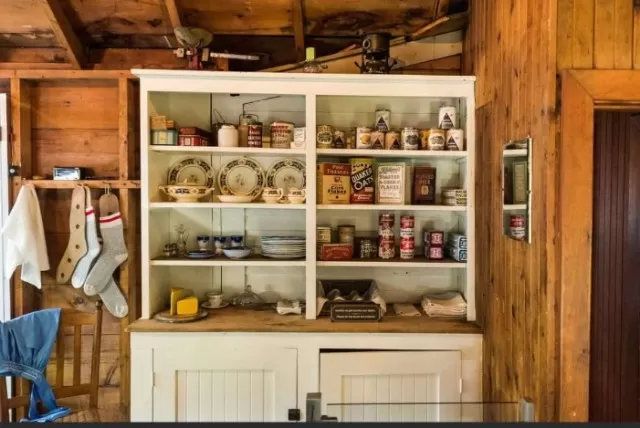Items to Avoid Storing in Your Attic for Safety. The opening statement sheds light on the potential dangers of using an empty attic as a storage space.
This revised title emphasizes the need to reassess the common practice of storing important items in attics due to the adverse effects caused by temperature variations and humidity. By drawing attention to these hazards, individuals will become more aware of the risks involved and seek more appropriate storage solutions to preserve their valuables.
Be Mindful of Storage

The wide expanse of an attic may appear to be the perfect solution for stashing away your belongings, but despite its allure, this space is far from ideal for preserving your cherished possessions.
The inhospitable conditions that often prevail in attics can spell disaster for many valuable items, leaving them vulnerable to the harmful effects of humidity, pests, and drastic temperature changes. To ensure the longevity and safety of your important documents and precious keepsakes, it’s crucial to avoid storing them in the attic.
Take extra precautions when selecting a suitable storage location for your valuable belongings.
Instead of the attic, consider options such as a climate-controlled room or a designated storage area that provides protection from the elements. Opt for a space with regulated temperature and humidity levels to shield delicate items from potential harm.
Additionally, proper packaging is essential to safeguarding your treasures.
Invest in high-quality, airtight containers that can shield your documents and keepsakes from moisture and pests. Utilize acid-free archival boxes for delicate documents to prevent deterioration over time.
Label each container carefully, making it easier to retrieve items when needed.
In the case of family heirlooms, antiques, or valuable artwork, consider seeking the advice of a professional conservator.
They can offer valuable insights into preserving and storing these items, ensuring they remain in pristine condition for generations to come.
Remember that proactive maintenance is vital for preserving your valuables.
Periodically inspect your stored items to detect any signs of damage or decay. If you notice any issues, take immediate action to rectify the situation and transfer the items to a safer storage environment if necessary.
By prioritizing careful storage and taking preventative measures, you can safeguard your cherished possessions and ensure they stand the test of time.
An investment in proper storage solutions and vigilance will undoubtedly pay off, allowing you to pass down these treasures to future generations with pride and peace of mind.
Handle Leather with Care
Leather, be it jackets, furniture, or gloves, demands special attention when it comes to storage.
The attic is definitely not the right place for these prized possessions. Leather’s natural properties make it susceptible to damage from extreme temperatures and frequent fluctuations, leading to dryness, brittleness, and unsightly cracks. Additionally, moisture is a significant threat to leather items, as it can lead to staining and degradation over time. Unfortunately, in the attic, the risk of irreversible damage is high, and by the time you notice it, it might be too late to salvage your leather goods.
To ensure the longevity of your leather items, consider these crucial guidelines for proper storage:.
Optimal Environment: Choose a storage area with stable and moderate temperature and humidity levels.
Ideally, a climate-controlled room or a cool, dry space indoors would be the best choices.
Avoid Direct Sunlight: Leather should never be exposed to direct sunlight for prolonged periods, as it can cause fading and discoloration.
Shield your leather items from UV rays to maintain their original luster.
Clean and Condition: Before storing leather goods, ensure they are clean and free from any dirt or residue.
Use a suitable leather cleaner and conditioner to maintain their suppleness and prevent drying out.
Moisture Control: Incorporate moisture-absorbing materials, like silica gel packs, to mitigate any excess humidity that could lead to mildew or mold growth.
Proper Packaging: Store leather items in breathable, dust-free covers like cotton sheets or fabric bags.
Avoid using plastic, as it can trap moisture and cause damage.
Regular Inspection: Periodically check on your leather belongings to spot any signs of deterioration early.
If you notice any issues, take appropriate measures promptly.
Professional Assistance: In case of significant damage or valuable leather items, consider consulting a leather expert or professional restorer to ensure the best preservation practices.
By treating your leather possessions with the care they deserve and providing them with an appropriate storage environment, you can enjoy their beauty and functionality for years to come.
Remember, proactive measures and thoughtful handling are the keys to preserving the timeless appeal of leather goods.
Safeguard Your Important Documents

The attic may seem like a convenient storage spot for boxes filled with tax returns, receipts, and various papers, but it’s crucial to rethink this practice.
Valuable documents such as birth certificates, medical records, passports, and other essential information should never find their way into the attic. The extreme temperatures and humidity commonly present in this area pose a significant risk of ruin for these important papers.
Paper is highly susceptible to the effects of humidity and heat.
While some documents may physically survive, the combination of moisture and elevated temperatures can wreak havoc on the ink and pencil marks, rendering them illegible over time. To ensure the preservation of your critical documents, follow these guidelines for proper storage:.
Optimal Storage Location: Choose an alternative storage area that maintains a stable, moderate temperature and humidity levels.
A climate-controlled room or a secure filing cabinet within your home are much better options.
Protective Containers: Store important papers in archival-quality, acid-free folders or boxes to protect them from deterioration caused by acids and other harmful substances found in ordinary paper products.
Organization: Categorize and label your documents clearly to make retrieval easy and efficient when needed.
This will prevent unnecessary handling, reducing the risk of wear and tear.
Digital Backups: Consider creating digital copies of your crucial documents and store them securely on an external hard drive or in a secure cloud storage service.
This provides an additional layer of protection in case the physical copies are damaged or lost.
Fireproof Safe: For especially sensitive documents, such as birth certificates or wills, invest in a fireproof safe to safeguard them from potential disasters.
Regular Inspection: Periodically examine your stored documents to check for any signs of degradation.
If you notice any issues, take immediate action to address them appropriately.
Proper Handling: Always handle your important papers with clean, dry hands to avoid transferring oils or moisture that can damage the documents over time.
By adopting these precautionary measures and refraining from storing your essential documents in the attic, you can ensure that they remain intact and accessible when you need them most.
Preserving these valuable records is essential for your peace of mind and the security of your personal information.
.
.
.
Caring for Your Musical Instruments
Whether it’s the clarinet you played in junior high band or the violin from your high school orchestra days, proper storage is essential for preserving these cherished musical instruments.
Wood instruments, in particular, require special care, as they are highly susceptible to damage when exposed to extreme temperatures. To ensure the longevity and quality of your instruments during storage, consider the following guidelines:.
Temperature Control: Choose a storage location with consistent room temperatures.
Avoid places that experience extreme heat or cold, as these temperature fluctuations can harm the delicate components of wood instruments. Ideally, a climate-controlled room within your home would be The Best Option.
Wooden Instrument Care: Wood instruments, like violins, are especially sensitive to changes in temperature and humidity.
Extreme heat can cause the adhesives in the instrument’s body to melt, leading to structural damage. Prevent direct sunlight exposure, as it can cause fading and warping of the wood.
Moisture Prevention: Mold is a significant threat to wood instruments.
Store them in a dry environment and consider using dehumidifiers in the storage area, especially in humid climates. Be cautious of damp basements or areas prone to Water Leaks.
Proper Instrument Cases: Use high-quality instrument cases with proper padding and fabric that resists moisture.
Cases should fit the instruments securely to prevent any movement during storage.
Regular Maintenance: Before storing your instruments for an extended period, ensure they are clean and in good condition.
Remove any moisture and dirt to prevent mold or corrosion.
Avoid Enclosed Spaces: Never store instruments in airtight plastic bags or containers, as they can trap moisture and lead to mold growth.
Insect Prevention: Use insect repellents specifically designed for musical instruments to protect them from bug infestations.
Inspect the instruments regularly to detect any signs of insect activity.
Professional Inspection: If you’re unsure about the proper care and storage of your instruments, consider consulting a professional instrument technician or luthier.
They can provide valuable advice and may offer maintenance services to keep your instruments in top condition.
By adhering to these guidelines and treating your instruments with care, you can preserve their quality and functionality over time.
Proper storage not only protects your instruments from damage but also ensures that they are ready to bring joy and music to your life whenever you decide to play them again.
Protecting Wool and Delicate Fabrics

When it comes to preserving wool blankets and clothing, as well as other delicate fabrics like linen and cotton, careful storage practices are essential.
Moths and other insects are attracted to these natural fibers, and even in the main Living Areas of your home, it can be challenging to keep them away. In an unfinished attic, the risk of bug problems significantly increases, making it an unsuitable storage location for such fabrics.
To ensure the longevity of your precious textiles, follow these guidelines:.
Proper Cleaning: Before storing wool and delicate fabrics, ensure they are clean and free from any dirt, stains, or food residues.
Moths are particularly drawn to soiled fabrics.
Storage Containers: Use airtight containers or sealed bags to protect your fabrics from insects and dust.
Avoid cardboard boxes, as they may not provide adequate protection against bugs.
Cedar Deterrents: Moths dislike the scent of cedar, so place cedar blocks or sachets near your stored fabrics to deter these insects.
Temperature-Controlled Environment: Whenever possible, store vintage and sentimental clothing in a temperature-controlled room.
Extreme temperatures can damage delicate fabrics, and a stable environment will help preserve their quality.
Avoid Direct Sunlight: Prolonged exposure to sunlight can fade and weaken fabrics, so store them away from windows or use blackout curtains to protect them.
Periodic Inspection: Regularly inspect your stored fabrics for any signs of pests or damage.
If you discover any issues, take immediate action to address them and prevent further harm.
Pest Prevention: Consider using natural insect repellents, like lavender or dried rosemary, to keep moths and bugs at bay.
Proper Folding: Fold fabrics gently and avoid using tight creases to prevent permanent wrinkles and stress on the fibers.
Acid-Free Tissue Paper: Place acid-free tissue paper between folds and layers to provide extra protection and prevent color transfer.
Humidity Control: Maintain a dry environment, as high humidity can lead to mold growth and damage natural fabrics.
By adhering to these storage guidelines and taking preventive measures, you can protect your wool and delicate fabrics from pests and ensure they remain in excellent condition for years to come.
Proper care and consideration will allow you to enjoy these cherished textiles for generations or repurpose them into beautiful keepsakes.
*The information is for reference only.